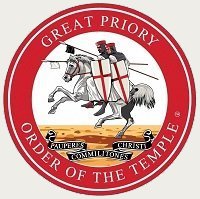Rothley Temple Preceptory No. 152
Warranted 11th April 1884 - Consecrated 5th February 1885
Meets at Freemasons' Hall, London Road, Leicester
on 1st Thursday in November, February and April at such time as the
Eminent Preceptor may appoint
Historical Preface
Rothley - anciently Rotelie, Rodolie, and Rodeley - from whence the name of our Preceptory is taken, although in itself only a comparatively small village, was from ancient times, and still is, the head of an extensive and important peculiar jurisdiction, the Soke of Rothley (Soke, from the Saxon Socne, signifying the power of administering justice, as also the circuit of a liberty, franchise, or local privileged jurisdiction). It still remains at the head of six or seven other manors, including the Chapelry of Gaddesby, where the church, a fine specimen of ecclesiastical architecture, was chiefly built by the Templars of Rothley; its beautiful south aisle (almost every stone of which bears its mason's mark) is probably unsurpassed by any village church in the land.
At the time of the Conquest the King held the Manor of Rothley, but which, in the reign of Stephen, was held by Ranulph, fourth Earl of Chester, from whom it passed to the Harcourts, who were Crusaders, and we learn from Nichols that it became the property of the Order of Knights Templar about the year 1218, when John de Harcourt, a Crusader in the Holy Land, gave a considerable part of his property in the Soke of Rothley to the Master and Brethren of the Temple of Solomon of Jerusalem. The Great Simon de Montfort, Earl of Leicester, also granted a considerable parcel of land at Rothley to the Templars, as well as a wood near Leicester called Rothley Wood, &c. Other gifts of land were also made.
It was at this time that Rothley became a Preceptory, and its Temple was built about the year 1230. In 1273 King Edward I. confirmed the Soke of Rothley to the Knights Templar, together with the church of Rothley, and the chapelries belonging to it of old.
On the suppression of the Knights Templar, Rothley Temple, like the other Possessions of the Order, devolved upon the Knights Hospitaller of St. John of Jerusalem, whose chief Preceptory in this County had long been at Dalby-on-the-Wolds, which manor had been given to them by one of the famous Norman Earls of Leicester – Robert Bossu, the founder of Leicester Abbey, and by that Order it was held until the dissolution of religious houses.
Rothley Temple came into the possession of the ancient family of Babington in 1567, and in modern times has become celebrated as the birthplace of Thomas Babington Macaulay, who was raised to peerage as Lord Macaulay of Rothley.
The church of Rothley, which was doubtless the work of the Templars, contains a tomb bearing the cross-legged effigy of a Knight of the Order – probably one of the Preceptors of Rothley – which was discovered in the Churchyard by Mr. Nichols, the historian, and removed for preservation into the Church early in the present century. A very ancient Runic Cross, about ten feet high, still stands on the south side of the Churchyard, of which no history or tradition exists.
The ancient chapel of the Preceptory, erected by the Knights Templar, and in which, after the suppression of the Order, -the Knights of St. John of Jerusalem assembled for their devotions, is still existing as part of the mansion. It is of considerable length, and whilst the west end has been walled off and secularised to domestic use as a laundry, the east end, where the family burials have taken place – the last being that of the late
Lady Parker – is still used for divine worship, and the family monuments have been restored.
From this ancient home of the Knights Templar in our immediate vicinity, so rich in associations of the past, we have adopted the titlt of our modern Preceptory of Rothley Temple. Long may it flourish, and long may it prove worthy of its distinguished name!
So mote it be.
Contact the Registrar
